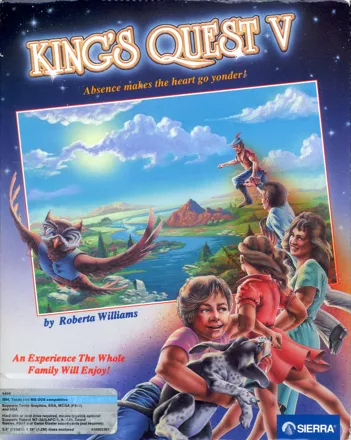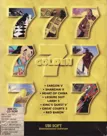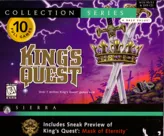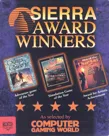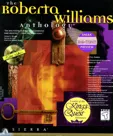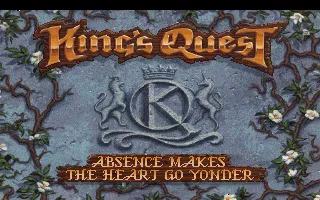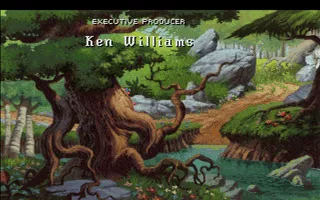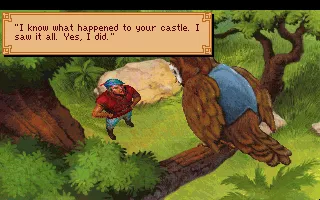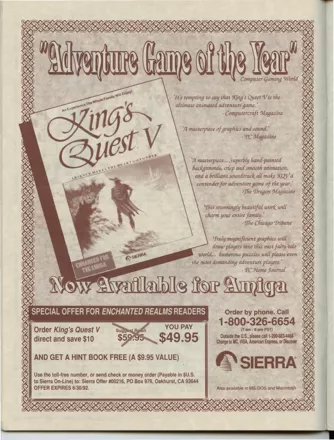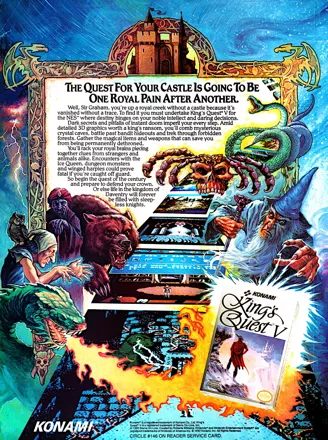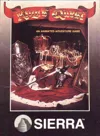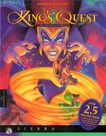King's Quest V: Absence Makes the Heart Go Yonder!
Description official descriptions
On a beautiful sunny day, King Graham of Daventry decides to take a stroll in the woods surrounding his castle. When he returns, he discovers with horror that his home, Daventry Castle, has completely disappeared! Graham is at a loss, and wonders how this could have happened, when a talking owl named Cedric appears. He tells him that he saw the whole thing, and that an evil wizard named Mordack whisked the entire castle away, along with Graham's family in it. Cedric offers to take him to his homeland, Serenia, where his master, the wizard Crispin resides. Surely Crispin will be able to help King Graham rescue his family from Mordack's clutches.
King's Quest V: Absence Makes the Heart Go Yonder is an adventure game, and the first from Sierra to use a point-and-click mouse interface. Rather than typing commands on a keyboard to interact with the game world and use the arrow keys to walk around, King's Quest V instead simplifies all actions down to base commands. To access the different cursors, the player can move the mouse to the top of the screen, revealing a hidden menu with each of the different actions, as well as game options and the inventory bag. By clicking the "Walk" cursor on the screen, Graham will walk as close as he can to the appropriate area. Clicking the "Eye" cursor on items will provide a description, the same as typing "Look at". The "Hand" cursor is a multipurpose cursor that can be used to push, pull, interact with and pick up objects. The "Head" cursor is used to talk to people (and in the strange world of King's Quest, often objects and animals, too). Players can also right-click to cycle through the different available cursors. Inventory that Graham picks up now gets placed into a bag. By clicking on the bag, this opens up a sub-window that displays all the inventory that Graham currently has. In here, players can look at or interact with objects, combine them with other objects, or pick them up to use them in the game environment as another cursor.
As with most Sierra games, it is quite possible to die. Bumping into witches, poisonous scorpions, falling off edges of cliffs, dying of thirst in the desert, and many other objects, locations and characters will send Graham to an untimely demise. The player must be cautious as they explore Serenia - frequent game saving across multiple files is usually the best course of action to make sure that you don't get stuck or have to start right from the game's very beginning.
The NES port of King's Quest V retains the icon-based interface and most of the locations, puzzles, and dialogue from the earlier release. Graphics had to be re-drawn with fewer colors and less detail to fit within the restrictions of the hardware, and the artwork in many areas is different.
This version removes most alternate solutions to puzzles and does not allow many actions that would render the game unwinnable. It also shortens and eliminates several scenes; for example, it is impossible to revisit the wizard in the first house. A few locations (such as the desert) are smaller. Some death sequences have been removed or modified not to include words related to death. Finally, some text descriptions were altered.
Spellings
- キングズ・クエストV - Japanese spelling
- 國王密使 V - Traditional Chinese spelling
Groups +
Screenshots
Promos
Credits (DOS version)
66 People · View all
| Executive Producer | |
| Creative Director | |
| Game Designer | |
| Art Designer | |
| Producer | |
| Lead Programmer | |
| Composers | |
| Documentation | |
| Creative Consultant | |
| Artists | |
| [ full credits ] | |
Reviews
Critics
Average score: 78% (based on 26 ratings)
Players
Average score: 3.8 out of 5 (based on 135 ratings with 12 reviews)
Graham & Cedric's NES Adventure
The Good
King Quest V: Absence Makes The Heart Go Yonder (herein after referred to as “King’s Quest V” or “KQ5”) is an impressive port of the PC DOS game of the same name.
The player takes control of a King Graham on a point and click, adventure quest to rescue his family members from the clutches of an evil sorcerer.
King Graham is coming home from a walk in the woods (apparently, he is so beloved by his people, that he does not require bodyguards), only to find that his castle (and the royal residents) have vanished, stolen by an evil sorcerer out for revenge.
Luckily, a talking Owl named, Cedric, saw the entire thing (in the event that the sorcerer later claims that he was just “Standing His Ground”). Cedric leads you to the home of his master, a kindly, wizard name, Crispin.
Crispin informs King Graham that the evil sorcerer is named Mordack who is seeking revenge on the family for what happened to his brother (King’s Graham's son transformed him into a cat in the third game).
Granted, if Mordack really wanted his brother back, he probably could have just bought the guide book to the third game, or sought out the help of more powerful wizards and warlocks. But, I guess some things are just beyond the power of an all-powerful, evil sorcerer.
Since King’s Graham’s son doesn’t know anything about magic (sigh, kids these days, am I right?), it is left to the father to save the day, before his family is fed to Mordack’s brother.
Crispin gives King Graham a root, which allows him to communicate with animals, a magical wand, which is broken, and instructs Cedric to follow you around (and try to be as fussy as C-3PO). He proceeds to vanish from the story, earning him the moniker; Crisipin: The Lord Of Exposition.
Once your quest becomes, you are free to maneuver King Graham around the different locations, pick up items for your inventory and interact with people, animals and familiar, but public domain, fairy tale characters
For the most part, King Graham is easy to control. The on-screen text is easy to read, the puzzles and solutions make sense and the game comes with a useful save feature (albeit with a password), plan on dying often.
Now, this game is hardly perfect. Some of the faults were carried over from the original PC edition, while some are unique to the NES edition.
The Bad
The original King’s Quest V game (1990) featured some truly stunning 16-bit VGA, 256 color-on screen visuals. This is not something that the NES port was capable of recreating.
The graphics in the PC edition look like a series of beautiful paintings, while the NES edition looks like 8-bit graphics trying so hard to resemble a 16-bit, VGA painting.
Clearly, the designers of the game were trying to get the best visuals from the NES hardware.
Some of the levels were slightly redesigned to try and look better on the 8-bit hardware, but the NES had a more limited pixel and color palette, then an early 1990s Amiga, Macintosh or PC computer. The game’s music suffered a similar fate.
I suspect that the NES is capable of better music then what is in King’s Quest V, but the designers seemed to have simply taken the music and sound effects from the PC edition and pushed them through the NES hardware.
As I said earlier, King Graham is generally easy to control. Notice that I used the word, “generally”. The game is not compatible with a mouse, and tries to replace the mouse in point and click adventuring games with the standard NES controller. Ouch!
Basically, you have to bring up an icon selection screen to pick up items, use items or talk to animals, people or other characters. While moving around is a simple matter of using the controller’s crosshairs, you will need to read the instructional manual carefully, and practice a bit with the “point and click” aspect of the game.
One you get the hang of it, it is not really a problem, except for one or two puzzles in the game (where you have to move fast and interact with small, 8-bit pixels).
Last, but not least, a few certain things in the NES edition were cut or censored.
As I am familiar with the original game, owned the PC DOS and PC CD-ROM editions back in the day, I will elaborate a few of the examples of stuff that was left on the cutting room floor for one reason or another.
Kings’ Quest V has a desert sequence and, near the end of the game, a dungeon sequence. In order to succeed in both of these sequences you need to have a photographic memory, or, you know, make a map. In the NES edition, both of these sequences seem a bit smaller, in comparison to the original computer edition.
Some of the “alternative” solutions in the original edition of the game have been removed from the NES port. You cannot, as an example, buy items with a golden heart. I am not sure if this was done to save memory or to avoid making the game too difficult.
Mostly minor differences, but people familiar with the original computer game, will notice.
Other changes in the game were probably made at the (cough, cough) “request” of Nintendo. In order to (legally) make games for a Nintendo system, you had to let them preview your game and agree to remove or obscure certain content, which Nintendo felt was not appropriate for “family friendly” gaming.
You can find an online copy of the Nintendo Content Guidelines (circa 1988), but the rules were especially concerned with sexuality, violence, and anything deemed to be religious or political proselytism.
King’s Quest V keeps its sexuality nice and wholesome, so not much for Nintendo to complain about in that department. A few characters fall in love, much like any classic fairy tale, but it is all “G” rated. However, the game does make a few offhand references to religion.
Nintendo was afraid that a religious denomination would be offended at how they were portrayed in a game, and they were also afraid that parents or politicians might accuse Nintendo or video games in general of promoting a particular religion.
Case in Point: In the desert sequence, King Graham needs to – periodically – drink water from one of the oases scattered around the desert.
In the original version of the game, King Graham thanks “the gods” when he drinks water, but in the NES edition the religious reference is deleted. Although whether or not such a reference actually violated the content guidelines is a bit debatable (albeit a moot point). Nintendo expressly allowed ancient mythology (especially Greek and Roman) in games designed for its system. It could be argued that King Graham is not giving thanks to an actual deity, but in light of the fact that the entire desert sequence is set in (vaguely) Middle Eastern, “1001 Nights-esque” setting, the censors probably opted to be on the safe side.
Nintendo’s rules regarding violence are the ones that most people are familiar with, largely because of the history involved in censorship the SNES port of the ultra-violent video game, Mortal Kombat. However, you did not need blood, gore and spinal cord removal to get noticed by the censors.
Nintendo insisted that some references or images in Kings Quest V were too violent. References to death were deleted.
Some of the death sequences were modified so that the death was less a sure thing and more of an implied, off-screen probability.
Hmm. Perhaps King Graham does not die as much as he “travels to another dimension” (as censored anime cartoons sometimes say, when they describe death)
These cuts and edits do not significantly distract from the enjoyment of the NES game, but they are noticeable.
The Bottom Line
Kings Quest V is a solid port of a classic adventure game. It is one of the few point and click adventure games ported over to the NES, and you can tell that the designers of the game really tried to push the hardware limitations of the system when it came to the game’s graphics and music. If you enjoy adventure games, and have the patience to learn the controls, then I would suggest locating a copy of this game.
NES · by Shamal Jifan (20) · 2023
Sierra's game interface takes a turn for the worse.
The Good
King's Quest V boasted beautiful VGA graphics, and was one of the very first games to have voice actors. The cosmetic upgrade really benefited Sierra's graphic adventure genre, but the game was desperately downgraded in my opinion. But this is one of computer gaming's great debates: the switch over from keyboard text parser - driven games to mouse-driven games. Did it help or hinder the genre? I'm of the opinion that the old text parser system was better, smarter, and more interactive.
The Bad
With King's Quest V the level of interaction became so -un-interactive, as you wandered around and were essentially told what to do. There are plenty of puzzles which are extremely simplified compared to puzzles of the previous king's quests. And the first CD version with the voice actors should have been edited better, as every time a voice was played it would sound like a door was opening; this could have been a sound card problem at the time. For me, the King's Quest series ended with this sub-par title because of its low interactivity level. In many ways King's Quest V would be an omen for what was to come a few years later in CD-ROM interactive movies, where players shelled out too much money to watch bad actors and bad scripts complain about their system requirements while they did little to interact with the game aside from buy a better graphics card so the game might look better. It began here, folks, and whether that is good or bad is entirely your own opinion.
The Bottom Line
Don't play King's Quest V as your first King's Quest. the first four are much better an introduction.
DOS · by Old man gamer (381) · 2000
Mix one park murk with one part dreck, add obfuscation. Chill and serve.
The Good
It's a Roberta Williams title
The Bad
Everything else: murky colors, difficult control system, cheap graphical shortcuts
The Bottom Line
A continuation of the King's Quest franchise, KQ5 was just as good as its predecessors... until it was added to the NES lineup. Working with the obvious space limitations of a cartridge-based game, Konami's port of KQ5 for the NES had to do away with Cedric's annoying voice, but it also meant having to do away with the rich VGA colors of the PC classic. Had Konami sat on the title until the SNES, we might have had a welcome addition to the adventure game catalog. As it was hastily thrown onto the 8-bit Nintendo, I had to prevent myself -- forcefully -- from ripping the Video Master rental out of my deck and smashing it.
NES · by horeck gruc'thalv (2) · 2005
Discussion
| Subject | By | Date |
|---|---|---|
| Color number in the Amiga version | Nowhere Girl (8680) | Aug 15, 2014 |
| Game freezing | Nowhere Girl (8680) | Jul 27, 2012 |
Trivia
A rare "king" game in the series
Despite the title of the series, there are only two installments where you actually play as a king (namely, King Graham): this one and King's Quest II.
CD version
The game was also released on CD-ROM. This CD version had full speech throughout the game.
Innovations
King's Quest V was the first adventure game to be released on CD-ROM in MPC (Multimedia PC) format, the first to have digitized voiceovers, the first to use digitized hand painted backgrounds, and the first title to cost over one million U.S. dollar to produce.
Installation
Installing the game on the PC was less intuitive than other Sierra releases due to the variety of options supported. An addendum to the manual was included which attempted to explain all of the installation options. The game could be played entirely from hard disk, half from hard drive and half on floppy, or entirely on floppy if two drives were present. If you were playing with one 3.5" drive and one 5.25" drive, installation began on either 5.25" disk #6 or 3.5" disk #10. All other combinations began installation on 5.25" disk #5 or 3.5" disk #9. (confused yet? King's Quest V may also be the only Sierra title where installation doesn't begin with either disk #1 or the Startup disk.) Probably in the interest of simplicity, media cost, and sanity most (if not all) of Sierra's later games shipped with just one set of disks per package eliminating the ability to play entirely from floppy but simplifying installation.
User interface
The first game in the King's Quest series (in fact, all classic Sierra adventures) to switch to icon control from the text parser system.
Versions
King's Quest V was the first Sierra game to be available in two separate versions: a 16 color version (supporting EGA, MCGA, VGA, and Tandy/PCjr graphics) and a 256 color version (supporting MCGA and VGA only). The 16 color version came with 10 3.5" DD disks and 6 5.25" HD disks. 5.25" DD (360k) disks could be ordered directly from Sierra. (A hard disk was required to use the 360k disks.)
Awards
- Computer Gaming World
- March 1992 (Issue #92) – Introduced into the Hall of Fame
- November 1991 (Issue #88) – Adventure Game of the Year
- November 1996 (15th anniversary issue) - #94 in the “150 Best Games of All Time”
- GameStar (Germany)
- Issue 12/1999 - #94 in the "100 Most Important PC Games of the Nineties" ranking
Information also contributed by Adam Baratz, Mitch Kocen, PCGamer77, Roger Wilco, Sciere and Servo
Analytics
Upgrade to MobyPro to view research rankings!
Related Sites +
-
Hints for KQ5
Wonderful question and answer hints will get you through the game at your own pace.
Identifiers +
Contribute
Are you familiar with this game? Help document and preserve this entry in video game history! If your contribution is approved, you will earn points and be credited as a contributor.
Contributors to this Entry
Game added by Andy Roark.
Amiga added by POMAH. NES added by totalgridlock. Windows 3.x added by ZZip. Macintosh, PC-98, FM Towns added by Terok Nor.
Additional contributors: Katakis | カタキス, Jeanne, Chentzilla, Xoleras, Игги Друге, Paulus18950, Patrick Bregger, Kayburt.
Game added May 23, 1999. Last modified April 18, 2024.
